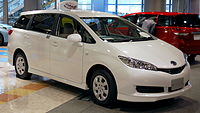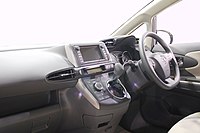Toyota Wish
This article needs additional citations for verification. (October 2020) |
| Toyota Wish | |
|---|---|
 Toyota Wish (ZGE20, Hong Kong) | |
| Overview | |
| Manufacturer | Toyota |
| Production | 2003–2017 |
| Body and chassis | |
| Class | Compact MPV |
| Body style | 5-door station wagon |
| Layout | Front-engine, front-wheel-drive Front-engine, four-wheel-drive |
| Platform | Toyota MC platform |
| Chronology | |
| Successor | Toyota Sienta Toyota Noah/Voxy/Esquire Toyota Prius α/Prius V |
The Toyota Wish (
Apart from Japan, the Wish was also assembled in Thailand (for Malaysia and Singapore) and Taiwan. It was also sold in Hong Kong, where it was imported from Japan.

First generation (AE10; 2003)
| First generation (AE10) | |
|---|---|
Toyota Vista (V50) | |
| Powertrain | |
| Engine | |
| Transmission |
|
| Dimensions | |
| Wheelbase | 2,750 mm (108.3 in) |
| Length | 4,560 mm (179.5 in) |
| Width | 1,695 mm (66.7 in) |
| Height | 1,590 mm (62.6 in) |
2003
The Wish was developed under code name "760N" by the team, led by chief engineer named
Codenamed ZNE10G (FWD) and ZNE14G (4WD), it uses a 1.8 L 1ZZ-FE engine, producing (JIS) 132 PS and 170 N⋅m (125 lb⋅ft). It is only available with four-speed automatic. A 2.0 L version (codenamed ANE11W for the six-seater version and ANE10G for the seven-seater version) was launched in March 2003. Equipped with the 1AZ-FSE direct-injection engine, it has (JIS) 155 PS (114 kW) and 192 N·m (142 lb·ft). Variants with the 2.0 D-4 engine are only available with a CVT gearbox.
The WISH was extremely successful in its home market, and is frequently seen on the Top 5 on the 30 bestseller list each month. It has also made shockwave to its competitors, such as the Honda Stream and Mazda Premacy/Mazda5 to changing its market positioning.
The Toyota Wish was also launched as a locally assembled model in Thailand in December 2003 following the compact MPV trend of Thailand at that time. The Wish in Thailand is available with 3 trim levels including 2.0 S, 2.0 Q and 2.0 Q Limited (with sunroof) and is very similar to the Japanese version, except for a few differences:
- Models across the range get the 2.0Z fenders.
- Standard 17-inch wheels across the range (Same design as the one used on the 2.0Z)
- Same 2.0 1AZ-FE engine as the ASEAN Camry instead of the 1AZ-FSE
- No privacy glass (excluding the grey-import variants)
- Leather upholstery as standard on the 2.0Q and 2.0Q Limited
- The rear Double wishbone suspension of 4WD models in Japan was fitted with 2WD model in Thailand as standard. (no Torsion beam rear suspension in Thai version).
2004
The Wish was launched in
2005
The Wish was updated at the end of 2005 with the introduction of a
For model year 2007 on Japanese models only,
2008
In Singapore, the local distributor brought in the Toyota Wish later in 2008 as a compact MPV to buyers there.[2] Instead of the generic Netz oval emblem found on the parallel imported Wish, the local distributor replaced the oval Netz emblem with the Toyota one. Sold as the Wish Aero Tourer to distinguish itself from the parallel import Wish; additional, accessories such as a 5-piece bodykit inclusive of a high mounted rear LED brake light, touchscreen DVD head unit, reverse camera, side mirror indicators, illuminated scuff plates, window visors, chrome muffler tip are featured as standard equipment. Previously, the Wish was only sold by parallel importers.
Gallery
-
Pre-facelift Toyota Wish 1.8X "S Package"
-
Facelift Toyota Wish 1.8X "E Package"
-
Facelift Toyota Wish 1.8X "E Package"
-
Facelift Toyota Wish 2.0Z
-
Facelift Toyota Wish 2.0Z
-
Taiwanese market pre-facelift Toyota Wish with different headlights, grille and bumper design as a taxi
-
Taiwanese market pre-facelift Toyota Wish 2.0J with different tail lights, emblem and rear bumper as a taxi
-
Taiwanese market facelift Toyota Wish with different headlights, grille and bumper design
-
Taiwanese market facelift Toyota Wish with different tail lights and rear bumper as a taxi
-
Interior
Second generation (AE20; 2009)
| Second generation (AE20) | ||
|---|---|---|
Curb weight | 1,355–1,380 kg (2,987.3–3,042.4 lb) | |
The second-generation Wish has been available for the Japanese market since March 2009. It is powered by Toyota's Dual VVT-i 2ZR-FAE and 3ZR-FAE engines. All models come with Toyota's 7-speed Super CVT-i transmission. The exterior dimensions remain similar to the previous generation, except for the length which has increased slightly.
The second generation Wish continued to be sold outside of the Japanese market in Hong Kong, Singapore[4] and Taiwan. These models had speedometer clusters that were slightly different from the Japanese market model in the km/h dials section.
The Wish received a facelift in April 2012. Cosmetic changes to the headlights and rear lamps featured LED insets, revised front grille, rear tailgate garnish and dashboard meter cluster were made.
Body styles
- 2WD
| Chassis code (DBA-) | ZGE22W-HWXQP | ZGE20W-HPXSP | ZGE20G-HPXEP | ZGE20G-HPXGP | ZGE20G-HPXNP |
|---|---|---|---|---|---|
| Model | 2.0Z 2WD | 1.8S 2WD | 1.8A 2WD | 1.8G 2WD | 1.8X 2WD |
| Engine | 3ZR-FAE | 2ZR-FAE | 2ZR-FAE | 2ZR-FAE | 2ZR-FAE |
| Seats | 6 | 7 | 7 | 7 | 7 |
- 4WD
| Chassis code (DBA-) | ZGE25W-HPXSP | ZGE25G-HPXEP | ZGE25G-HPXGP | ZGE25G-HPXNP |
|---|---|---|---|---|
| Model | 1.8S 4WD | 1.8A 4WD | 1.8G 4WD | 1.8X 4WD |
| Engine | 2ZR-FAE | 2ZR-FAE | 2ZR-FAE | 2ZR-FAE |
| Seats | 7 | 7 | 7 | 7 |
Engines
| Code | Years | Type/code | Power, torque at rpm |
|---|---|---|---|
| 2ZR-FAE (2WD) | 2009–2018 | 1,797 cc (109.7 cu in) (80.5x88.3mm) I4 | 144 PS (106 kW; 142 hp) at 6,400, 176 N⋅m (130 lb⋅ft) at 4,400 |
| 2ZR-FAE (4WD) | 2009–2018 | 1,797 cc (109.7 cu in) (80.5x88.3mm) I4 | 133 PS (98 kW; 131 hp) at 6,400, 164 N⋅m (121 lb⋅ft) at 4,400 |
| 3ZR-FAE | 2009–2018 | 1,986 cc (121.2 cu in) (80.5x97.6mm) I4 | 158 PS (116 kW; 156 hp) at 6,200, 196 N⋅m (145 lb⋅ft) at 4,400 |
Transmissions
| Model(s) | Type |
|---|---|
| 1.8S | Super CVT-i with 7-speed sport sequential shiftmatic with CVT Sport Mode |
| 1.8A, 1.8G, 1.8X | Super CVT-i with 7-speed sport sequential shiftmatic |
| 2.0Z | Super CVT-i with 7-speed sport sequential shiftmatic with Dynamic Sport Mode |
Handling
All models include safety features such as
Gallery
- Japanese market
- Taiwanese market
Discontinuation
Sales of the Wish was discontinued in Taiwan in 2016, where it was replaced by the Sienta, and was also discontinued in Japan on 13 October 2017 and in Singapore in mid 2018,[5] where Prius α and the Sienta replaced the outgoing Wish. In Japan, the role of the Wish as a three-row compact MPV is effectively replaced by the Sienta, the Prius α and the tall-bodied Noah/Voxy/Esquire triplets.
References
- ^ "國瑞汽車股份有限公司" [Kuozui Motor Company Ltd.]. Taiwan: Kuozui Motor Company. Retrieved 2010-10-17.
- ^ "Borneo Motors brings in the Toyota Wish". Retrieved 2008-06-01.
- ^ "Japanese Production Sites" (Press release). Japan: Toyota. 2016-03-06. Archived from the original on 2015-03-18.
- ^ "Toyota launches the sequel to Singapore's most successful MPV". Retrieved 2009-10-31.
- ^ "トヨタ ラインナップ | 現在販売していないクルマ | WISH" [Toyota Lineup | Cars not currently on sale | WISH] (in Japanese). Japan: Toyota. Retrieved 2018-04-23.






















